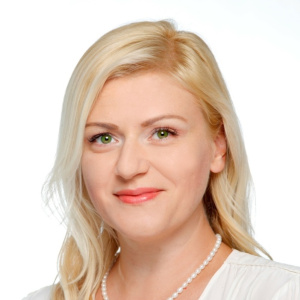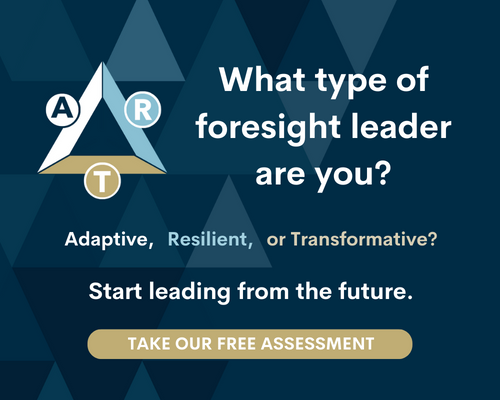Living Companies: Turning Insight into Foresight to Tame the Future

In order to understand why I have such a strong passion for foresight, it’s helpful to get a glimpse into my background. For 15 years, I worked internationally in the field of Marketing, Innovation and Business Strategy across different FMCG, Finance and Entertainment blue-chip companies (AB InBev, Societe Generale, Disney), as well as successfully growing start-ups. Most recently, I held a Consumer Strategy role at The Walt Disney Company. Working in a highly analytic strategy job yet experiencing a passion for innovation, I was motivated to ignite change despite the challenging circumstances. During my first month on the job, external forces outside of our control started dismantling the plans we had set for the coming year. First, there was the migrant crisis in France, followed by terror attacks, the Brexit referendum, and wild economic fluctuations. I spent the next several years juggling between reactive actions in an attempt to try meet quarterly targets, while still seeking to anticipate the potential driving forces and their impact on the future of our business. In hindsight, I could have collected all the historical data possible, and I still could not have predicted what I experienced.
I often thought to myself, “What if there was a way that I could have looked at external factors and imagined multiple possibilities, even if seemingly outrageous?” Could such a planning approach have helped us prepare for a prosperous marriage between strategy with innovation? Soon thereafter, I found out the answer was yes! My curiosity and desire to experiment brought me in the room with Yvette Montero Salvatico and Frank Spencer – the co-founders of the foresight, innovation and strategic design firm Kedge – as well as 24 other Disney colleagues. We were selected from a pool of 400 candidates to complete training to become the next Disney Futurists. During the first day of training, the fire within me turned into fireworks. And I wasn’t alone! There were other “outliers” who believed that there had to be a better way. At the same time, I was completing a Strategy and Innovation program at Saïd Business School, University of Oxford, so I decided to focus my studies on how Strategic Foresight can empower companies to be more resilient to external influences and become better prepared for the future. That’s how my foresight journey began. And I am here today, happy to share my experience through platforms such as The Future Speaks and, hopefully, turn fire into fireworks for someone else.
Now, you probably have a better understanding of why I take every opportunity to tell other organizational leaders how living companies can turn insight into foresight to tame the future. The average lifespan of a company today is less than 20 years. However, in the late 1950s, it was 60 years. What happened? People are usually quick to respond, “It’s because of technology.” Sure, exponential technological change is a fact, but digital transformation shouldn’t be the scapegoat for all of our problems. As a point of comparison, there are companies who have existed for over 700 years. For instance, the Swedish Stora (est. 1288) and the Japanese Sumitomo (est. 1590) are the longest living companies in the world. They survived the Middle Ages, two World Wars, and the Industrial Revolution. They are thriving in the Fourth Industrial Revolution as well, while many of their counterparts are floundering. What has made these companies resilient in the face of a drastically changing environment?
In the 1980s, Arie De Geus’ Scenario Planning team at Royal Dutch Shell embarked on a journey to answer a similar question. The team wanted to identify and understand traits of successful companies who were older than Shell’s 100-year old organization. They found that some of the key traits of these “Living Companies” included: A clear awareness of identity; sensitivity to the world around them; and a high tolerance to new ideas. If we know that these traits are critical to a Living Company, and then we look at how strategy is developed and executed in most organizations, it is no surprise that longevity is shrinking. Traditional business strategy utilizes very linear approaches, extrapolating historical data into the future and largely assuming that the past will repeat itself. We end up with a very unlikely “official future” and forecasts motivated by the financial interests of shareholders rather than accounting for macro trends and societal value shifts. Companies further reinforce this non-adaptive approach through their structures, talent sourcing, policies, and culture. Such companies may succeed in a rather stable environment, but they are ripe for disruption and collapse in the volatile, uncertain, complex, and ambiguous landscape of the 21st century.
So, how does an organization intentionally chart the path to become a Living Company? Strategic Foresight – a structured framework that equips leaders with the mindset and toolkit necessary to navigate these uncertain times – incorporates the traits of a Living Company through its actionable approach. Foresight does not predict the future – it does something better! It guides organizations through a process, using quantitative and qualitative methods to map simultaneous possible futures. It empowers us to become the owner of our own destinies in order to create vision, form strategy, and take actions today to reach that desired future. Unlike traditional methods, it reaches far beyond competition, helping to identify possible disruptors and new opportunities outside of our industry. In other words, foresight best informs our strategic decisions when it is integrated into the organizational culture, engaging all levels of the organization and running in the background of all business processes. In reality, remaining a Living Company in the 21st century requires us all to think and act like futurists.
Now that you have this information, you may be wondering what to do next. It’s simple. Times are changing, and not only the success but the very survival of our companies is at stake. We don’t want to miss the obvious answers just because we are comfortable in our old ways. In this landscape, questioning is more important than being correct, and curiosity is more beneficial than being safe. Being correct is a very temporary state. We have to find a way to tame the future and foresight is the answer.

The Future Speaks program is a unique apprenticeship that pairs TFSX alumni with diverse conference speaking opportunities. With a database of hundreds of global events to choose from and over a decade of pitching experience, TFSX serves as your conference concierge, helping you achieve your foresight thought leadership and development goals. Email us for more information.

Joana Lenkova
Strategic Foresight Director at Creative Play Lab, The LEGO Group
Certified Foresight Practitioner
Joana has 15 years of international experience in the field of Marketing, Innovation and Business Strategy, and Strategic Foresight, across blue-chips (AB InBev, Societe Generale) and start-ups. Most recently, she held a Consumer Strategy role at The Walt Disney Company. In April 2019 she founded Futures Forward – a Strategy and Futures consultancy.
Graduate of Saïd Business School, University of Oxford in Strategy and Innovation and being passionate about building future-proof business strategies, Joana focused her research on how Strategic Foresight helps organizations innovate.
She is a member of the Global Foresight Advisory Council of The Futures School, the Association of Professional Futurists and the Oxford Union.
Learn More
